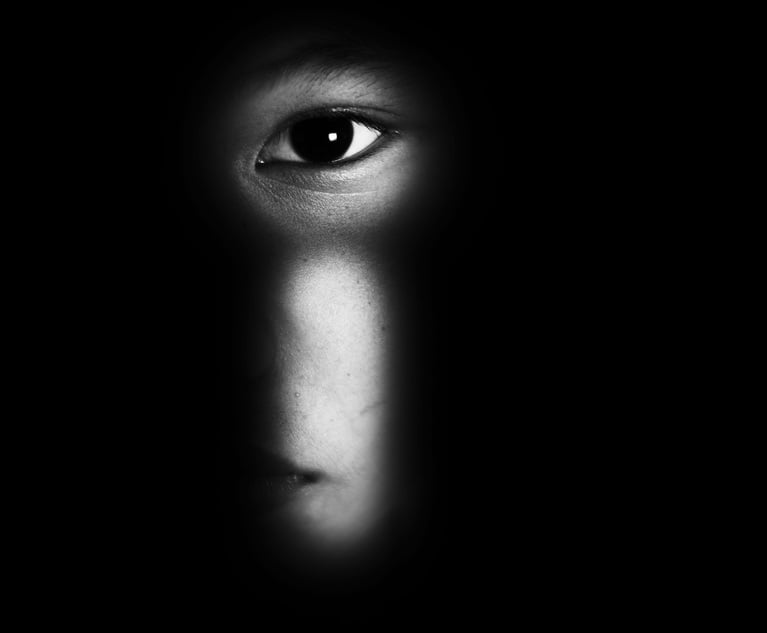Case of Doctor's Testimony Shift Teaches a Lesson to Lawyers
However the justices decide the present case before them, the moral to trial attorneys is simply this: Be alert to potential error in an adversary's trial presentation and make the appropriate objection, with underlying legal argument, at the time of its occurrence.
November 12, 2018 at 09:30 AM
5 minute read
 Credit: BigStock
Credit: BigStock
There is a tension between court and lawyers when a determination has to be made by the court as to whether an attorney's breach of a court rule should visit harm on that attorney's client. The appellate court has a difficult task in some instances determining whether trial error should result in a reversal and remand for a new trial because “it clearly appears that there was a miscarriage of justice under the law.” R.2:10-1. And more so, if the appellant's attorney failed to properly object to a critical trial court ruling. There the measuring rod is whether the error was “clearly capable of producing an unjust result.” R.2:10-2. Although the verbiage differs, the language of both rules indicate that the examined error must be of such a magnitude as not to be “harmless error,” but rather one which had a significant impact on the outcome below.
Reasonable persons and reasonable judges can differ on the point at which error, R.2:10-1, morphs into the plain error of R.2:10-2, thereby producing the unjust result which requires reversal.
This brings us to the recent medical malpractice case of T.L. v. Goldberg, 453 N.J. Super. 539, in which, as the result of a dissenting opinion, the case is now to be decided by the Supreme Court. The court has framed the issue for its decision as, whether defense counsel's failure to disclose in interrogatory answers and deposition testimony that his client's testimony would differ from his discovery responses constitutes plain error. In answering the interrogatory, defendant stated that he did not recall relying on any medical text or publication related to his treatment and in his deposition testified that he was not aware of any studies in a certain medical journal as to the use of the medication he prescribed to treat his patient's blood disorder. However, at trial he did in fact rely on an article from that journal which suggested that the prescribed medication might be an effective treatment for T.L.'s condition. Plaintiff's attorney failed to object to the defendant doctor's reference to that article which, of course, should have been done based on the prior discovery responses, until plaintiff's motion for a new trial.
The majority held that defense counsel's failure to disclose the anticipated material change in testimony misled the plaintiff, and that defendant “should not be rewarded for violating a duty of candor to the court and other counsel.” It concluded that the trial court's failure to grant a mistrial was a sufficiently clear abuse of discretion to invoke the plain error rule.
The dissenting judge concluded that the failure of plaintiff's attorney to object to the testimony at the appropriate time did not constitute plain error because the defendant's “brief references to a clinical study during his more than four hours of testimony” did not represent a clear miscarriage of justice requiring reversal of the jury's verdict under the plain error rule.
The majority opinion comments on plaintiff's failure to object to the critical testimony: “The silence is inexplicable.” The dissenting judge, however, did not find it inexplicable. Rather, her interpretation was that plaintiff's counsel, a seasoned veteran “accomplished at fashioning trial tactics and strategies,” purposely withheld objection as part of his strategy. It suggested to her that plaintiff's attorney perceived no error or prejudice. In fact, plaintiff's attorney had relied on the same article in his opening and as part of plaintiff's proofs.
Plaintiff's counsel did not even cross-examine the defendant doctor as to the discrepancy between his interrogatory answers and deposition testimony as contrasted with his testimony at trial. Neither did plaintiff's attorney request the trial judge to implement his pretrial ruling barring use of the medical literature by defendant and, finally, directed his cross-examination of defendant to the substance of the journal article. In other words, since the exclusion criteria in the journal article supported plaintiff's theory of negligence, he purposely did not object and, therefore, was not “clearly prejudiced” by the testimony. Although admitting defense counsel should have advised plaintiff prior to trial of his intended use of the journal article, she stated, “I cannot conclude that the failure to do so, without objection, requires a new trial.”
A guiding principle of judicial decision, as noted in the 1955 Supreme Court case of N.J. Highway Authority v. Renner, is that the court must never lose sight of the fact that “justice is the polestar and our procedures must ever be moulded and applied with that in mind” and the caution in the 1986 Appellate Division case of Santos v. Estate of Santos, 217 N.J. Super. 411, 416 that the “primary mission of the judiciary is to see justice done in individual cases. Any other goal, no matter how lofty, is secondary.”
However the justices of the court may view the specific facts in this case in order to reconcile the competing arguments of counsel, the moral to trial attorneys is simply this: Be alert to potential error in an adversary's trial presentation and make the appropriate objection, with underlying legal argument, at the time of its occurrence.
This content has been archived. It is available through our partners, LexisNexis® and Bloomberg Law.
To view this content, please continue to their sites.
Not a Lexis Subscriber?
Subscribe Now
Not a Bloomberg Law Subscriber?
Subscribe Now
NOT FOR REPRINT
© 2025 ALM Global, LLC, All Rights Reserved. Request academic re-use from www.copyright.com. All other uses, submit a request to [email protected]. For more information visit Asset & Logo Licensing.
You Might Like
View All
As Trafficking, Hate Crimes Rise in NJ, State's Federal Delegation Must Weigh in On New UN Proposal
4 minute read
Appellate Court's Decision on Public Employee Pension Eligibility Helps the Judiciary
5 minute read
Where CFPB Enforcement Stops Short on Curbing School Lunch Fees, Class Action Complaint Steps Up
5 minute read
'Confusion Where Previously There Was Clarity': NJ Supreme Court Should Void Referral Fee Ethics Opinion
4 minute readTrending Stories
- 1‘Facebook’s Descent Into Toxic Masculinity’ Prompts Stanford Professor to Drop Meta as Client
- 2Pa. Superior Court: Sorority's Interview Notes Not Shielded From Discovery in Lawsuit Over Student's Death
- 3Kraken’s Chief Legal Officer Exits, Eyes Role in Trump Administration
- 4DOT Nominee Duffy Pledges Safety, Faster Infrastructure Spending in Confirmation Hearing
- 5'Younger and Invigorated Bench': Biden's Legacy in New Jersey Federal Court
Who Got The Work
J. Brugh Lower of Gibbons has entered an appearance for industrial equipment supplier Devco Corporation in a pending trademark infringement lawsuit. The suit, accusing the defendant of selling knock-off Graco products, was filed Dec. 18 in New Jersey District Court by Rivkin Radler on behalf of Graco Inc. and Graco Minnesota. The case, assigned to U.S. District Judge Zahid N. Quraishi, is 3:24-cv-11294, Graco Inc. et al v. Devco Corporation.
Who Got The Work
Rebecca Maller-Stein and Kent A. Yalowitz of Arnold & Porter Kaye Scholer have entered their appearances for Hanaco Venture Capital and its executives, Lior Prosor and David Frankel, in a pending securities lawsuit. The action, filed on Dec. 24 in New York Southern District Court by Zell, Aron & Co. on behalf of Goldeneye Advisors, accuses the defendants of negligently and fraudulently managing the plaintiff's $1 million investment. The case, assigned to U.S. District Judge Vernon S. Broderick, is 1:24-cv-09918, Goldeneye Advisors, LLC v. Hanaco Venture Capital, Ltd. et al.
Who Got The Work
Attorneys from A&O Shearman has stepped in as defense counsel for Toronto-Dominion Bank and other defendants in a pending securities class action. The suit, filed Dec. 11 in New York Southern District Court by Bleichmar Fonti & Auld, accuses the defendants of concealing the bank's 'pervasive' deficiencies in regards to its compliance with the Bank Secrecy Act and the quality of its anti-money laundering controls. The case, assigned to U.S. District Judge Arun Subramanian, is 1:24-cv-09445, Gonzalez v. The Toronto-Dominion Bank et al.
Who Got The Work
Crown Castle International, a Pennsylvania company providing shared communications infrastructure, has turned to Luke D. Wolf of Gordon Rees Scully Mansukhani to fend off a pending breach-of-contract lawsuit. The court action, filed Nov. 25 in Michigan Eastern District Court by Hooper Hathaway PC on behalf of The Town Residences LLC, accuses Crown Castle of failing to transfer approximately $30,000 in utility payments from T-Mobile in breach of a roof-top lease and assignment agreement. The case, assigned to U.S. District Judge Susan K. Declercq, is 2:24-cv-13131, The Town Residences LLC v. T-Mobile US, Inc. et al.
Who Got The Work
Wilfred P. Coronato and Daniel M. Schwartz of McCarter & English have stepped in as defense counsel to Electrolux Home Products Inc. in a pending product liability lawsuit. The court action, filed Nov. 26 in New York Eastern District Court by Poulos Lopiccolo PC and Nagel Rice LLP on behalf of David Stern, alleges that the defendant's refrigerators’ drawers and shelving repeatedly break and fall apart within months after purchase. The case, assigned to U.S. District Judge Joan M. Azrack, is 2:24-cv-08204, Stern v. Electrolux Home Products, Inc.
Featured Firms
Law Offices of Gary Martin Hays & Associates, P.C.
(470) 294-1674
Law Offices of Mark E. Salomone
(857) 444-6468
Smith & Hassler
(713) 739-1250






